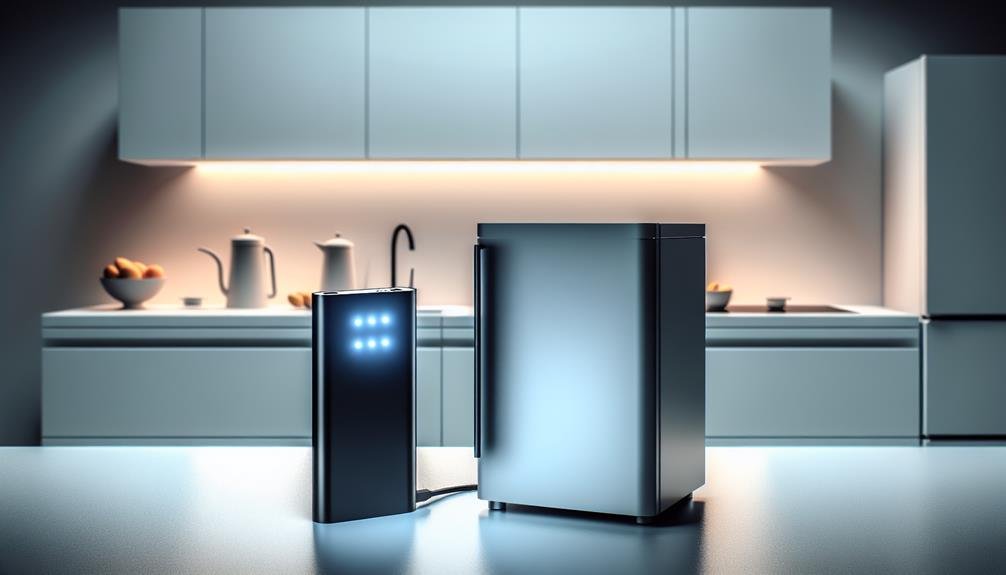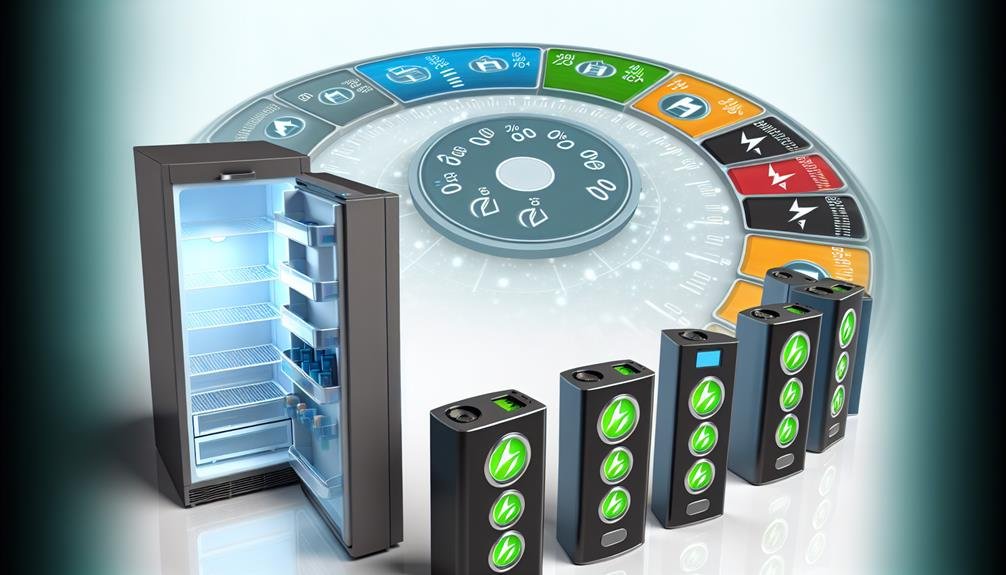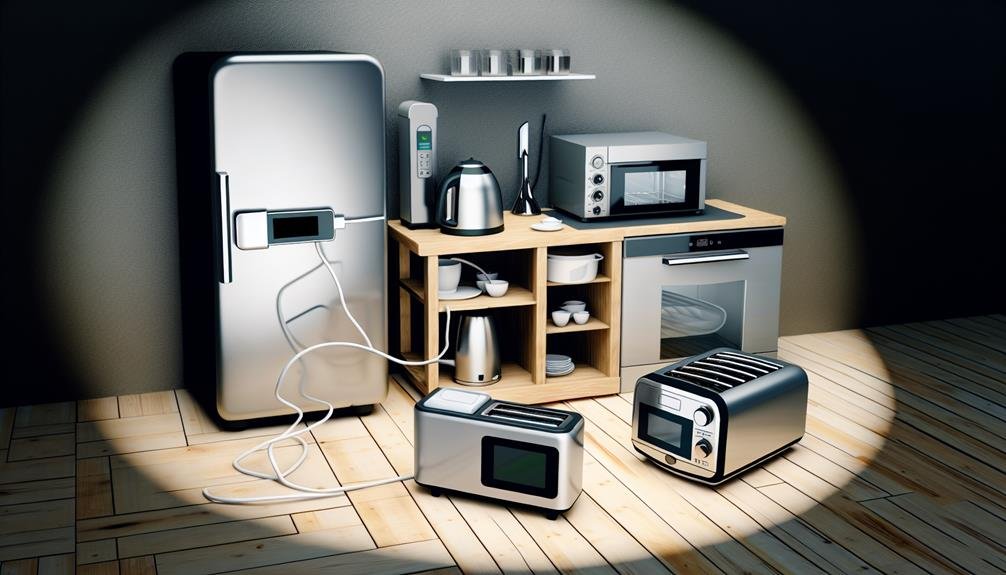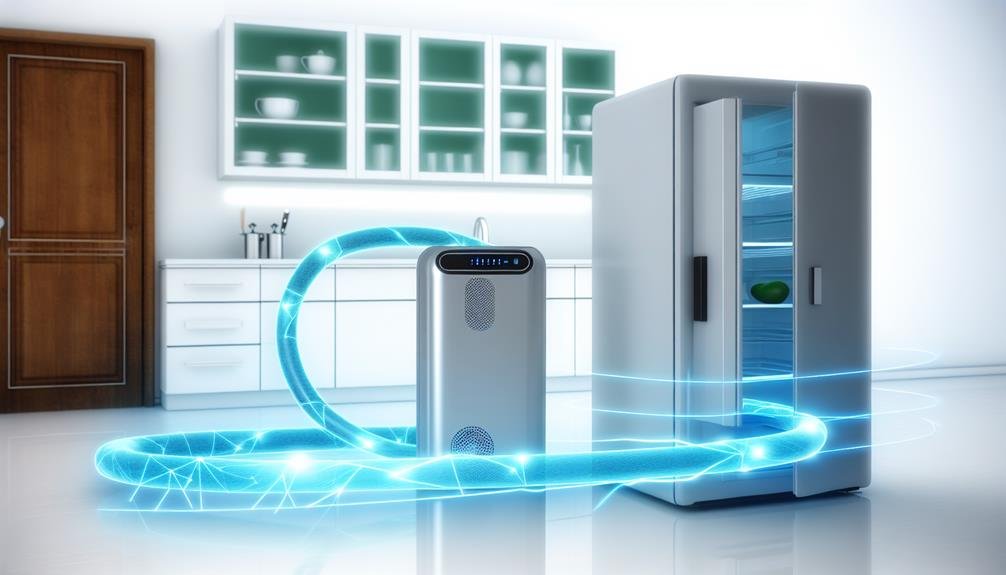Using a power bank to run a fridge is technically possible but requires careful consideration. Most power banks output up to 100W, while fridges typically consume between 100-800 watts, depending on size and efficiency. You'll need to match the power bank's voltage and wattage to the fridge's requirements. High-capacity power banks or solar generators are often used for this purpose. Confirm that the power bank has the necessary capacity in watt-hours (Wh) to meet the fridge's daily energy consumption, which can range from 1 to 8 kWh. For a deeper understanding of compatibility factors and practical setups, continue exploring the topic.
Power Bank Basics

A power bank is essentially a portable battery designed to recharge electronic devices when access to a standard electrical outlet isn't available. You'd typically use it to extend the battery life of your smartphones, tablets, or other gadgets. Power banks come in various capacities, usually measured in milliampere-hours (mAh), which determine how many times they can recharge your device.
When considering energy efficiency, especially if you're using solar panels to recharge your power bank, it's important to understand how different models perform. Solar-powered power banks convert sunlight into electrical energy, which can be a sustainable and effective way to keep your devices charged. However, the efficiency of solar panels varies, so always check the conversion rate and position the panels in ideal sunlight.
Safety is paramount when using a power bank. Always use the manufacturer-recommended cables and avoid overcharging your devices, as this can lead to overheating or even battery damage. Also, ensure your power bank has built-in safety features like overcharge protection, short circuit protection, and temperature control. These features maintain the longevity and safety of both the power bank and your charging devices, making your investment reliable and secure.
Energy Requirements of Fridges
Understanding the energy requirements of fridges is crucial when considering whether a power bank can effectively run one. Fridge power consumption varies greatly depending on the model, size, and energy efficiency. Generally, a small fridge might consume around 100-200 watts, while larger models can demand up to 800 watts. Modern fridges with high energy efficiency ratings are designed to minimize power use, thereby offering more sustainable refrigeration options.
To gauge the feasibility of using a power bank, you need to analyze the fridge's daily energy consumption, typically measured in kilowatt-hours (kWh). Here's a breakdown to help you understand the implications:
| Fridge Type | Daily Consumption (kWh) |
|---|---|
| Small (100-200W) | 1-2 kWh |
| Medium (200-400W) | 2-4 kWh |
| Large (400-800W) | 4-8 kWh |
| Energy-Efficient | 0.8-1.5 kWh |
When planning for safety, it's critical to ensure the power source can consistently meet these demands. Using a power bank that can't handle the fridge's power consumption may result in inefficient cooling or even damage to the appliance. Additionally, opting for fridges with better energy efficiency can notably reduce the overall energy requirements, making sustainable refrigeration options more viable for off-grid or emergency scenarios.
Power Bank Capacities

How do you determine if a power bank's capacity is sufficient to run a fridge? First, consider the fridge's wattage and daily energy consumption. A fridge typically requires 100-800 watts. Multiply this by the hours it runs daily to get the total watt-hours needed. Next, check the power bank's capacity, listed in milliamp-hours (mAh) or watt-hours (Wh). Convert mAh to Wh for accurate comparison (1 mAh = 0.0037 Wh).
Battery lifespan and charging cycles are essential. Power banks degrade over time; their effective capacity decreases. Most high-quality power banks offer 300-500 charging cycles before significant performance loss. Choose a power bank with a capacity buffer to account for this degradation.
Portable charging solutions, including those with solar panels, can extend usability. Solar panels can recharge the power bank during daylight, but they need ideal conditions to be effective. Ensure the power bank supports solar input and has adequate input voltage and current ratings.
Always prioritize safety. Use power banks with built-in protections against overcharging, short-circuiting, and overheating. These features safeguard both your devices and the power bank, ensuring reliable and safe operation.
Compatibility Factors
When evaluating compatibility factors, you must consider the fridge's voltage and wattage requirements alongside the power bank's capacity. Ensuring the power bank can meet the fridge's startup surge and continuous operation is essential. Additionally, battery capacity should be sufficient to sustain the fridge for an extended period without frequent recharges.
Voltage and Wattage Requirements
Determining whether a power bank can run a fridge depends on matching the fridge's voltage and wattage requirements with the power bank's output capabilities. A fridge typically demands a stable power source, making it essential to understand both the power bank limitations and compatibility factors. You need to confirm that the power bank can handle the fridge's energy efficiency and appliance requirements without causing any safety issues.
To start, check the voltage and wattage specifications for both the fridge and the power bank. Most household fridges operate on 120V or 240V, with wattage varying between 100W to 800W, depending on size and features. Here's a quick reference to help you:
| Specification | Typical Range |
|---|---|
| Voltage (Fridge) | 120V or 240V |
| Wattage (Fridge) | 100W to 800W |
| Power Bank Output | Typically up to 100W |
Next, assess the power bank's output. Most power banks designed for portable electronics may not exceed 100W, posing a significant limitation. Always verify that the power bank's output matches or exceeds the fridge's voltage and wattage requirements. Confirming compatibility will prevent potential damage to both the appliance and the power bank, maintaining efficiency and safety.
Battery Capacity Considerations
Understanding battery capacity considerations is crucial for guaranteeing that your power bank can effectively run a fridge without depleting its energy reserves too quickly. You need to analyze battery efficiency, which dictates how much of the stored energy can be converted into usable power. Higher efficiency means more of the battery's charge is available to run your fridge.
Next, consider size constraints. A power bank with larger capacity (measured in watt-hours or amp-hours) will last longer but may be bulkier and less portable. Confirm the power bank's size aligns with your usage scenario while providing sufficient capacity for the fridge's needs.
Temperature regulation and power consumption are also critical factors. Fridges require a significant amount of power, especially when cooling down initially or maintaining a low internal temperature. You must calculate the fridge's average power consumption in watts and guarantee your power bank can supply this consistently over the required duration.
Additionally, extreme temperatures can affect battery efficiency. Make sure your power bank and fridge are operated within recommended temperature ranges to avoid loss of efficiency and potential safety hazards. Securing these considerations will help maintain both the longevity and safety of your power setup.
Real-World Scenarios

When considering real-world scenarios, you'll find that a power bank running a fridge can be important for emergency power solutions, necessary during camping and outdoor adventures, and essential for preparing for power outages. Each scenario demands understanding the power bank's capacity and the fridge's energy consumption to guarantee reliable performance. Analyzing these factors will help you determine if this solution meets your specific needs.
Emergency Power Solutions
In real-world emergency scenarios, a power bank can serve as an important backup solution to keep significant appliances like a fridge running. However, you should first assess the energy requirements of your fridge and the capacity of your power bank to guarantee compatibility. A typical fridge consumes around 100-800 watts, depending on its size and efficiency, so it's vital to have a power bank with sufficient watt-hour (Wh) capacity.
In addition to power banks, other viable options include portable generators and solar panels. Portable generators offer a reliable solution for extended outages but require fuel and proper ventilation. Solar panels, when paired with a battery storage system, provide a renewable energy source, though they rely on sunlight availability.
You could also consider using a car battery or wind turbines. A car battery, with the appropriate inverter, can temporarily power a fridge but may deplete quickly. Wind turbines, while less common, can offer consistent power in windy conditions but require specific setups and maintenance.
Camping and Outdoors
Often, campers and outdoor enthusiasts face the challenge of keeping essential appliances like fridges running, making it important to think about portable power solutions. When you're out in the wilderness, having reliable portable cooling can be vital for food safety and comfort. A power bank can be a practical solution, but you need to take into account energy efficiency and capacity.
When selecting a power bank for your camping fridge, make sure it's capable of handling the fridge's power requirements. Portable cooling units vary significantly in their energy consumption, so check the wattage and runtime. Generally, a fridge would need a power bank that can deliver a steady output of 12V to 24V.
Take into account these factors:
- *Energy efficiency*: Choose fridges designed for low power consumption to maximize battery life.
- *Battery capacity*: Larger capacity power banks (measured in mAh or Wh) provide longer runtimes, ensuring your food stays fresh.
- *Safety features*: Look for power banks with overcharge protection and temperature control to prevent any hazards.
Power Outages Preparation
While power banks are valuable for camping, they're equally indispensable for preparing your home for power outages, guaranteeing critical appliances like fridges continue operating. When the grid goes down, your primary concern is food preservation. A power bank can keep your fridge running, preventing spoilage and guaranteeing you have safe food throughout the outage.
Effective emergency planning involves understanding your power needs. Here's a breakdown to help you assess:
| Appliance | Power Requirement (Watts) | Duration (Hours) |
|---|---|---|
| Fridge (Standard) | 100-800 | 8-24 |
| LED Light Bulb | 10-15 | 10-20 |
| Mobile Charger | 5-10 | 10-30 |
| Laptop | 40-60 | 5-10 |
| WiFi Router | 5-20 | 10-20 |
For food preservation, calculate your fridge's wattage and match it with your power bank's capacity. A power bank with a higher watt-hour (Wh) rating will be more effective. For instance, a 500Wh power bank can run a 100W fridge for approximately 5 hours. Incorporate these calculations into your emergency planning to guarantee you're adequately prepared.
Alternative Solutions
Consider utilizing solar-powered generators as an alternative solution for running a fridge when traditional power sources are unavailable. Solar panels can convert sunlight into electricity, which is then stored in a portable generator. This setup guarantees that your fridge remains operational, even during extended power outages, providing peace of mind and preserving food safety.
Here are some key benefits:
- Environmentally friendly: Solar panels reduce your carbon footprint, offering a sustainable energy source.
- Dependability: Portable generators with solar capabilities provide consistent power, especially in emergencies.
- Cost-efficient: After the initial investment, solar energy can greatly lower your electricity bills.
When selecting a solar-powered generator, make sure it has the appropriate wattage and battery capacity to handle your fridge's power requirements. Typically, a fridge needs around 100-800 watts, depending on its size and energy efficiency. It's essential to calculate the total energy consumption and choose a generator that provides at least 20% more power than needed to accommodate energy losses and inefficiencies.
Furthermore, verify that the generator includes safety features such as overcharge protection, short-circuit prevention, and temperature control. These features can prevent accidents and extend the lifespan of both your generator and fridge. Following these precautions will help you maintain a safe and dependable power source for your essential appliances.
Future Possibilities

Emerging technologies and advancements in energy storage could revolutionize how we power household appliances like fridges in the near future. As energy-efficient fridges become more prevalent, they'll use significantly reduced power, making it feasible for a power bank to sustain them for longer periods. The sustainability advantages of such energy-efficient models are immense, reducing both electricity bills and carbon footprints.
Technological advancements are also paving the way for smart fridge integration. Smart fridges can optimize their internal temperatures and adapt to usage patterns, further minimizing power consumption. Combining these with next-generation power banks that offer higher capacities and faster charging capabilities, you could maintain refrigerator functions even during extended power outages or in off-grid scenarios.
For those who prioritize safety, it's vital to use power banks with built-in protective mechanisms like overcharge protection and temperature control. As these technologies evolve, the synergy between energy-efficient fridges and advanced power banks could become a dependable, sustainable solution for keeping your food fresh and safe, even when conventional power sources are unavailable. This forward-thinking approach guarantees both environmental and personal safety, aligning perfectly with modern energy needs.
Frequently Asked Questions
What Are the Safety Risks of Using a Power Bank With a Fridge?
You're risking voltage compatibility issues, fire hazards, and overheating concerns. Electrical safety is paramount; power banks aren't designed for high-drain appliances like fridges. Misuse could lead to serious hazards, including potential fires and equipment damage.
How Do Temperature Fluctuations Affect Power Bank Performance?
Have you ever wondered if temperature fluctuations impact power bank efficiency? They do. Extreme temperatures can reduce battery lifespan, causing your power bank to perform poorly. To guarantee safety, keep your power bank within recommended temperature ranges.
Can Using a Power Bank Void the Fridge's Warranty?
Using a power bank could void the fridge's warranty due to power bank compatibility and warranty implications. Confirm the power bank capacity can support fridge performance to avoid potential risks and maintain safety standards.
Are There Eco-Friendly Power Banks Suitable for Running a Fridge?
Yes, there are eco-friendly power banks with solar power and high efficiency suitable for running a fridge. Look for models with substantial battery capacity and durability to guarantee reliable performance while prioritizing safety and environmental impact.
What Is the Cost Comparison Between Using a Power Bank and Traditional Power Sources?
Considering cost comparison, you'll find that energy efficiency and cost effectiveness vary. Traditional power sources often offer better reliability. Power bank capacity might not be sufficient, making traditional sources safer and more suitable for consistent fridge operation.



